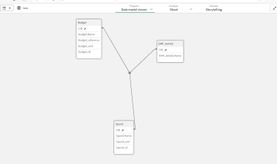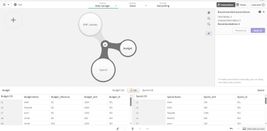- Mark as New
- Bookmark
- Subscribe
- Mute
- Subscribe to RSS Feed
- Permalink
- Report Inappropriate Content
Not showing correct sum amount in Bar chart with association
Hello Genius,
I am new to qlik sense and I need your support.
I have three table(A,B,C) in which CID is common. In Table B and C, value for Budged_id and Spend_id is Common but not common as per CID.
I have associated the table as per CID. now I am trying to show comparison between budget and Spend amount as per Budget_Id but it is not giving correct amount for Spend. If I create seperate chart as per Budget_ID and Spend ID then value shows correct amount.
Please provide your help.
Accepted Solutions
- Mark as New
- Bookmark
- Subscribe
- Mute
- Subscribe to RSS Feed
- Permalink
- Report Inappropriate Content
What about renaming the spend and budget field names so they are identical and the concatenate the two into one transaction table. Add a field to that table that indicates if it is a budget or spend transaction.
Qlik Community MVP
- Mark as New
- Bookmark
- Subscribe
- Mute
- Subscribe to RSS Feed
- Permalink
- Report Inappropriate Content
Meant is to merge both tables by concatenating them (union in sql) by harmonizing all field-names and data-structures as possible - an extra single field containing the source-information is enough to be able to differentiate between them in dimensions, selections and set analysis conditions.
Reason is that spend and budget have mainly the same information - only the point of view is different. Such measurement is usually very simple and solves many challenges within the data-model - especially getting all available data in each view (which isn't possible by missing keys on any side with table-associations) and in associating common dimensions.
- Mark as New
- Bookmark
- Subscribe
- Mute
- Subscribe to RSS Feed
- Permalink
- Report Inappropriate Content
That's really an odd behavior of a measure.
Do you use the same measures in both charts?
Do you use the same application/script when creating those charts.
How is the datamodel? Can you send a picture of how it looks or post the script you are using?
Qlik Community MVP
- Mark as New
- Bookmark
- Subscribe
- Mute
- Subscribe to RSS Feed
- Permalink
- Report Inappropriate Content
I did another look. Your app tsbles are joined by CID. In the joined table you have BudgetID is dimension, and if you look at which CIDs that are associated to each Budget ID you will find that the chart is correct.
For the single measure chart showing spend you dont use the same dimension for the bars.
You might want to find another way to associate the tables in your application.
Qlik Community MVP
- Mark as New
- Bookmark
- Subscribe
- Mute
- Subscribe to RSS Feed
- Permalink
- Report Inappropriate Content
Yes dear, you are right. I am not sure how to associate these table so that I can get the correct value.
- Mark as New
- Bookmark
- Subscribe
- Mute
- Subscribe to RSS Feed
- Permalink
- Report Inappropriate Content
What about renaming the spend and budget field names so they are identical and the concatenate the two into one transaction table. Add a field to that table that indicates if it is a budget or spend transaction.
Qlik Community MVP
- Mark as New
- Bookmark
- Subscribe
- Mute
- Subscribe to RSS Feed
- Permalink
- Report Inappropriate Content
I am not clear on this. Can you please do it for me.
- Mark as New
- Bookmark
- Subscribe
- Mute
- Subscribe to RSS Feed
- Permalink
- Report Inappropriate Content
Meant is to merge both tables by concatenating them (union in sql) by harmonizing all field-names and data-structures as possible - an extra single field containing the source-information is enough to be able to differentiate between them in dimensions, selections and set analysis conditions.
Reason is that spend and budget have mainly the same information - only the point of view is different. Such measurement is usually very simple and solves many challenges within the data-model - especially getting all available data in each view (which isn't possible by missing keys on any side with table-associations) and in associating common dimensions.


